Wealth and Assets in Scotland 2006 - 2012
This report presents analysis of Scottish data from the Wealth and Assets Survey 2006-2012, with a particular focus on findings from the third wave of the survey, covering the period 2010/12. This updates the report Wealth and Assets in Scotland 2006-10, which was published in May 2014.
3. The Distribution of Wealth in Scotland
This chapter considers how wealth is distributed in Scotland, by splitting the population into different sized groups. Findings are presented for aggregate wealth, as well as for the four components of wealth. This chapter also looks specifically at the distribution of wealth within the wealthiest decile.
Key points:
- In 2010/12, the wealthiest 10 per cent of households owned 44 per cent of all wealth, while the least wealthy 50 per cent owned 9 per cent of wealth.
- The wealthiest 10 per cent of households owned 4.8 times as much wealth as the least wealthy 50 per cent of households combined; and 20.8 times as much as the least wealthy 30 per cent of households.
- Wealth inequality is more stark then income inequality. While the 10 per cent highest income households earned around 25 per cent of all household income, the wealthiest 10 per cent of households owned almost 45 per cent of all wealth. The wealthiest 2 per cent of households alone owned 17 per cent of all personal wealth in Scotland.
- There was a slight reduction in the inequality of aggregate total wealth over time in Scotland. The share of wealth owned by the wealthiest 10 per cent of households fell from 49 per cent in 2006/08 to 46 per cent in 2008/10 and 44 per cent in 2010/12. This was driven mainly by a fall in the value of pension wealth held by the wealthiest households.
- The relative distribution of wealth across households was broadly similar between Scotland and Great Britain as a whole.
- Financial wealth was the most unequally distributed component of total wealth, with the most wealthy 10 per cent of households owning almost three quarters of financial wealth, while the least wealthy 50 per cent owned less than 1 per cent.
- Physical wealth was the most equally distributed wealth component. The wealthiest 10 per cent of households owned 33 per cent of physical wealth, while the least wealthy 50 per cent owned 20 per cent of all physical wealth.
3.1.1 Household wealth and household income inequality
Charts 3.1 and 3.2, overleaf, show household income and household wealth by percentile. Percentiles divide the data, in ascending order into one hundred equal parts so that each part contains 1 per cent of the population in Scotland. The lowest income / least wealthy households are shown in the 1st percentile moving up to the highest income / wealthiest.
Chart 3.1: Distribution of household income in Scotland, 2012/13
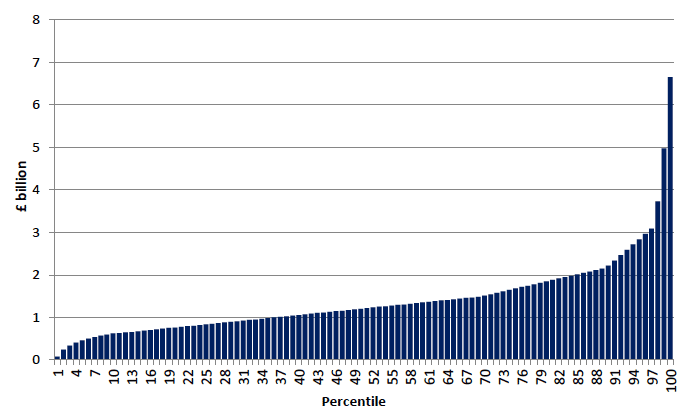
Source: Households Below Average Income, DWP
Note: Due to fluctuations caused by small numbers this chart has been smoothed. As such, the figures presented are estimates intended to show the shape and scale of the distribution only.
Chart 3.2: Distribution of household total wealth in Scotland, 2010/12
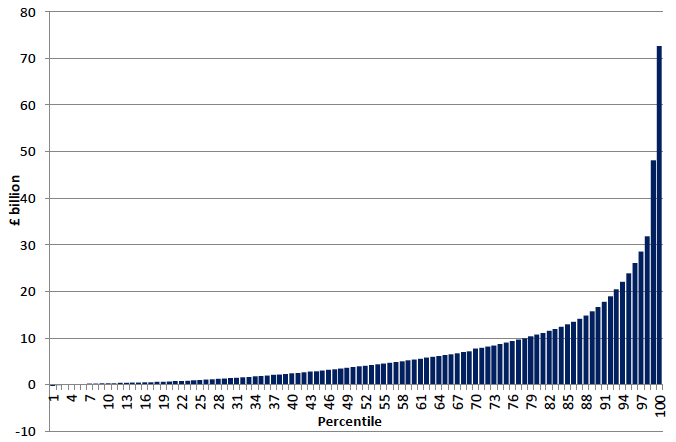
Source: Wealth and Assets Survey, ONS
Note: Due to fluctuations caused by small numbers this chart has been smoothed. As such, the figures presented are estimates intended to show the shape and scale of the distribution only.
Note that the scale of the chart showing the share of wealth is ten times larger than that for income.
The two charts, considered together, show that income is less unequally distributed than wealth. Chart 3.1 shows a relatively flat distribution, with the exception of a 'spike' towards the top end of the distribution. In 2012/13, the top 10 per cent of households had around 25 per cent of all household income, but the rest of the population had incomes within a relatively narrow range, with only small differences between percentiles.
Chart 3.2 shows a much more polarised distribution for wealth. After increasing gradually over most of the distribution, the curve of the graph then has an exponential shape, starting off very low and then rising very steeply. The range of values for each percentile is much wider than for incomes. The wealthiest 10 per cent of households owned 44 per cent of wealth. The top 2 per cent alone owned 17 per cent of all personal wealth in Scotland.
The distribution of wealth is discussed in more detail in the sections below.
3.1.2 Aggregate total household wealth by decile, across the three waves
Chart 3.3 shows aggregate total wealth by decile for 2006/08, 2008/10 and 2010/12. Deciles are similar to percentiles, but divide the data into ten equal parts so that each part contains 10 per cent of households - from the least wealthy households in the 1st decile to the wealthiest in the 10th decile. For a methodological explanation of how wealth deciles are calculated, please see Appendix 1.
Chart 3.3: Aggregate household wealth by decile, 2006/08 - 2010/12
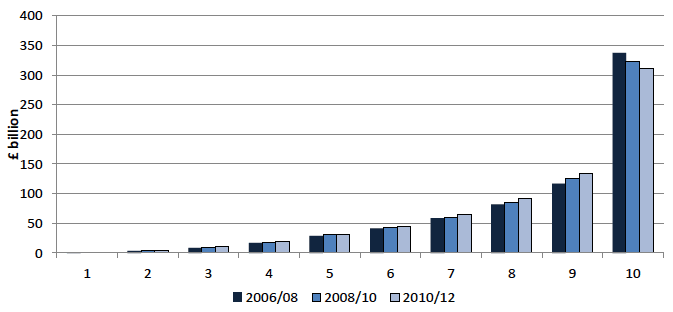
Source: Wealth and Assets Survey, ONS
Note: In wave 1, data on physical wealth was only collected for approximately half of the sample. In order to split the population into deciles, only those that have values for all wealth types are used. Analysis based on deciles may therefore not match the total values for the population but are intended instead to represent the distribution of wealth within the population.
Chart 3.3 suggests that the bottom three deciles own almost no wealth at all.
- The least wealthy 10 per cent of households owned little or no wealth over 2006/08 to 2010/12;
- The least wealthy 20 per cent owned less than 1 per cent of wealth, but with a small increase in share of wealth across the three waves;
- The least wealthy 30 per cent of households increased their share of wealth from just under two per cent in 2006/08 to just over two per cent in 2010/12.
It is only when households move into the fourth decile that they are able to accumulate wealth to any degree. The least wealthy 40 per cent of households increased their share of wealth from four per cent in 2006/08 to five per cent of all private wealth in Scotland in both 2008/10 and 2010/12.
Chart 3.3 also shows that the total value of wealth owned across the bottom 90 per cent of households increased between 2006/08 and 2010/12. For the least wealthy households, however, the increases in the value of that wealth were small. The wealthiest 10 per cent of households have seen consecutive decreases in the total value of wealth owned over the three periods, but still have considerably more wealth than those in decile 9. This last point is discussed further in the next section.
3.1.3 Inequality in aggregate total household wealth
This section discusses the aggregate wealth of selected deciles and groups of deciles in 2010/12, as set out in Chart 3.4 below. In 2010/12, the wealthiest 10 per cent of households (the top decile) owned 44 per cent of total wealth. The wealthiest 20 per cent (the top two deciles) owned 62 per cent of all private wealth in 2010/12.
Chart 3.4: Aggregate household wealth, selected groups, 2010/12
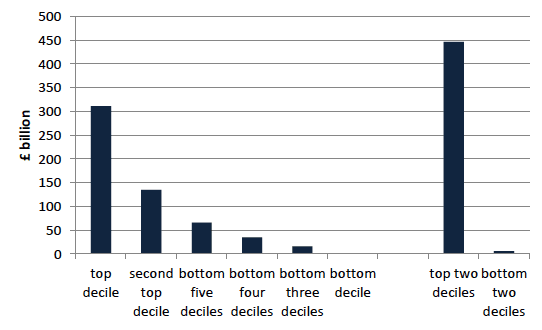
Source: Wealth and Assets Survey, ONS
The left hand side of chart 3.4 illustrates a range of ratios between the wealthiest 10 per cent and other deciles in 2010/12. To summarise, the wealthiest 10 per cent owned:
- 4.8 times more than the bottom 50 per cent of households combined (who owned 9 per cent of private wealth). This is a decrease from 5.2 in 2008/10 and 5.9 in 2006/08.
- 8.9 times more than the bottom 40 per cent of households combined. This was a decrease from 10.2 in 2008/10 and 11.6 in 2006/08.
- 20.8 times more than the bottom 30 per cent combined. Again, this was a fall from 24.0 in 2008/10 and 28.3 in 2006/08.
- 445 times more than the bottom decile. This is a substantial decrease from 1070 in 2008/10, which was an increase from 840 in 2006/08. [However, see first paragraph below.]
- 2.3 times more than the second wealthiest 10 per cent, a decrease from 2.6 in 2008/10 and 2.9 in 2006/08.
It should be noted that the ratios between deciles tend to be quite volatile. This is particularly the case for the ratio between the wealthiest 10 per cent and least wealthy 10 per cent, cited above, which is highly sensitive to very small changes in the wealth of the least wealthy group, which is very close to zero. Care should therefore be taken when interpreting the results, and it may be more useful to think of changes in inequality ratios in terms of indicating the general trend in inequality, rather than focusing on the values.
The right hand side of Chart 3.4 shows the wealthiest 20 per cent of households and the least wealthy 20 per cent. In 2010/12, the wealthiest 20 per cent owned 62 per cent of all private wealth, 87 times more than the bottom 20 per cent. Again, the ratio was lower than in previous years, falling from 115 in 2008/10 and 126 in 2006/8
The bullet points above set out a general reduction in inequality of aggregate total wealth over time. This reduction was primarily due to the fall in the value of wealth for the wealthiest 10 per cent of households over the period, as discussed in the section above. The aggregate wealth of this group fell by about £10 billion between 2008/10 and 2010/12, a 3 per cent fall, and by about £15 billion between 2006/08 and 2008/10, a fall of 4.5 per cent. The share of wealth held by the wealthiest 10 per cent of households fell from 49 per cent 2006/08 to 46 per cent in 2008/10 and continued to fall to 44 per cent in 20010/12.
3.1.4 Comparing wealth inequality in Scotland with Great Britain as a whole
Wealth inequality in Great Britain as a whole in 2010/12 was the same as in Scotland in terms of the percentage of wealth owned by the wealthiest 10 per cent of households (44 per cent) and the ratio of the wealthiest 10 per cent to the bottom 50 per cent of households (a ratio of 4.8).
On other measures of inequality, Scotland was slightly more equal in 2010/12. For example, the wealthiest 10 per cent of households were 22.3 times wealthier than the least wealthy 30 per cent of households in Great Britain, but only 20.8 times wealthier in Scotland. The largest difference was in terms of the ratio between the top two deciles and the bottom two deciles, which was significantly higher in Great Britain (where the top two deciles were 105 times as wealthy as the bottom two deciles) than in Scotland (where this ratio was 87).
Inequality ratios for Great Britain as a whole did not change in a consistent direction over the three survey waves, falling between 2006/08, and then increasing slightly between 2008/10 and 2010/12. The fall in inequality in Scotland over the three survey waves means that it has gone from being more unequal to being slightly less unequal than Great Britain as a whole over the last six years on these measures.
3.1.5 Aggregate total household wealth of the wealthiest households
Chart 3.2 above showed a concentration of wealth at the very top of the distribution. While the wealthiest 10 per cent of households owned 44 per cent of all private wealth in 2010/12, much of the wealth was actually held in the top two percentiles. The wealthiest 2 per cent of households owned 17 per cent of all household wealth in Scotland, while the wealthiest 1 per cent owned 11 per cent in 2010/12.
The concentration of wealth within the very wealthiest households is present across all wealth types:
- The wealthiest 1 per cent of households owned 29 per cent of all financial wealth, 10 per cent of pension wealth, 8 per cent of property wealth, and 4 per cent of physical wealth.
- The wealthiest 2 per cent of households owned one third (33 per cent) of all financial wealth in Scotland in 2010/12. They also owned 18 per cent of pension wealth, 13 per cent of property wealth and 7 per cent of physical wealth.
Chart 3.5 shows the value of wealth owned by the wealthiest 10 per cent of households in 2010/12, by percentile. This shows that the value of financial and property wealth owned by the wealthiest 1 per cent of households is significantly higher than in the rest of the top decile. Indeed, the wealthiest 1 per cent owned nearly half (49 per cent) of the financial wealth held by the top decile.
Chart 3.5 Value of assets owned by the wealthiest 10 per cent of households, by percentile
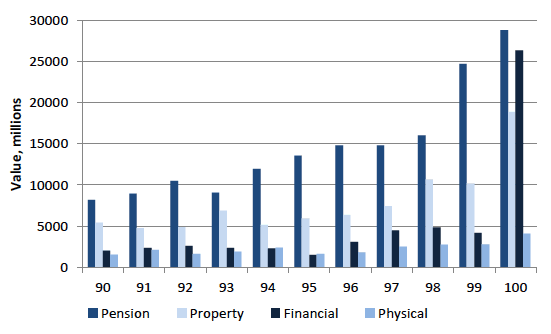
Considering the characteristics of the wealthiest households provides some context for these findings. Households in the wealthiest 10 per cent are significantly more likely to be headed by an older individual. The median age of the head of household for those in the wealthiest 10 per cent was 60 years, compared with 43 years for households in the middle of the wealth distribution. As wealth is accumulated through life, households with older individuals have longer to build up their assets, including property and pension wealth. The wealthiest 10 per cent of households are significantly more likely to own their property outright - 72 per cent are mortgage free, with 26 per cent paying a mortgage. This compares with 31 per cent of the whole population owning their property outright. As net wealth is measured here, the full property value is included as an asset where there is no mortgage.
Contact
Email: Stephen Smith
There is a problem
Thanks for your feedback